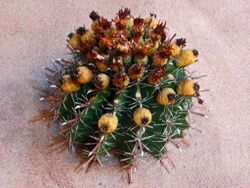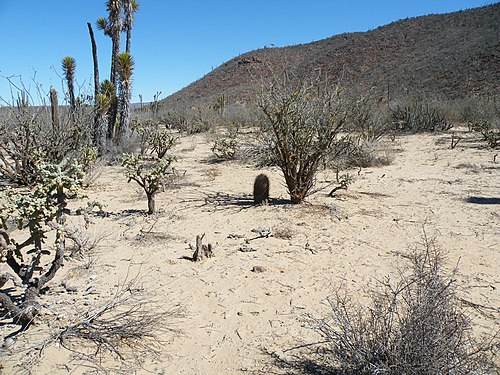Biology:Ferocactus peninsulae
| Ferocactus peninsulae | |
|---|---|

| |
| Scientific classification | |
| Kingdom: | Plantae |
| Clade: | Tracheophytes |
| Clade: | Angiosperms |
| Clade: | Eudicots |
| Order: | Caryophyllales |
| Family: | Cactaceae |
| Subfamily: | Cactoideae |
| Genus: | Ferocactus |
| Species: | F. peninsulae
|
| Binomial name | |
| Ferocactus peninsulae (F.A.C.Weber) Britton & Rose, 1922
| |
| Synonyms | |
| |
Ferocactus peninsulae is a barrel cactus in the genus Ferocactus of the family Cactaceae.
Description
Ferocactus peninsulae reaches a height of about 70 centimetres (28 in), rarely 2.5 meters, with a diameter of 40 centimetres (16 in). This plant is oval to club-shaped and has 12 to 20 showy, deep ribs. The thorns are grayish-red and have a yellowish or whitish tip. The central spines are banded and 4 to 15 centimeters long with the lowest central spine is flattened and curved in a hook shape and the 6 to 13 different, radial spines are slender occasionally twisted and bristle-like. The funnel-shaped flowers are red to yellow and reach a length of 5–6 centimetres (2.0–2.4 in). The fruits are spherical, yellow, up to 4.5 centimetres (1.8 in) long.[2]
Distribution
Ferocactus peninsulae is found in the Mexican state of Baja California Sur growing on sandy hillsides at an elevation of 0 to 450 meters. Plants grow in association with Mammillaria dioica, Cochemiea setispina, Echinocereus ferreirianus and Lophocereus schottii[3]
Taxonomy
In 1896, Frédéric Albert Constantin Weber first described this species as Echinocactus peninsulae.[4] The name "peninsulae" originates from Latin, meaning "peninsula," in reference to the species' presence on the Baja California peninsula. Nathaniel Lord Britton and Joseph Nelson Rose transferred the species to the genus Ferocactus in 1922.[5]
References
- ↑ Biología, Héctor Hernández (Instituto de; Group), Succulent Plants Specialist (2012-02-06). "The IUCN Red List of Threatened Species". IUCN Red List of Threatened Species. https://www.iucnredlist.org/species/152609/121542446. Retrieved 2024-01-22.
- ↑ N. L. Britton; J. N. Rose (1922) (in German), The Cactaceae. Descriptions and Illustrations of Plants of the Cactus Family, Band III, Washington: The Carnegie Institution of Washington, pp. 133
- ↑ "Ferocactus peninsulae". 2013-08-04. http://www.llifle.com/Encyclopedia/CACTI/Family/Cactaceae/11977/Ferocactus_peninsulae.
- ↑ D&Amp, Um National; (France), histoire naturelle (1895). "Bulletin du Muséum d'histoire naturelle". Impr. nationale. https://www.biodiversitylibrary.org/page/5027725.
- ↑ Britton, Nathaniel Lord; Eaton, Mary E.; Rose, J. N.; Wood, Helen Adelaide (1919). The Cactaceae : descriptions and illustrations of plants of the cactus family. Washington: Carnegie Institution of Washington. doi:10.5962/bhl.title.46288.
External links
Wikidata ☰ Q1407496 entry
 |








